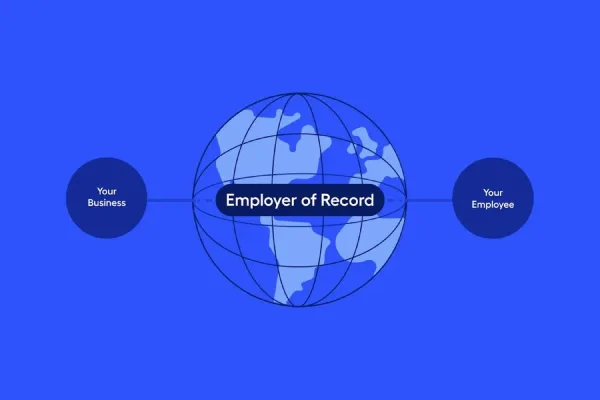Attention COOs, HR Leaders & Talent Heads! This one’s for you
If you are leading a mid to large-sized company and scaling across borders, this article is your go-to source on Global Workforce Management.
From international hiring and compliance to payroll and employee experience, learn how to manage a global workforce with chaos.
Let’s get started to build high-performing borderless teams.
The Rise of Borderless Markets
In the past, only multibillion dollar giants had to worry about international employment laws and cross-border compliance.
But times have changed.
As globalization accelerates, small and mid-sized businesses are now engaging in:
- International trade
- Serving clients abroad
- Hiring remote talent
- Sourcing skills globally
This expansion exposes companies to global employment and regulatory frameworks, making global workforce solutions essential.
So, what’s driving this global leap?
- Digital Transformation: Digital tools have made it easy to sell and communicate worldwide.
- Logistics Progress: Faster shipping has made global delivery less painful.
- Competitive Domestic Markets: Tough competition at home is pushing companies to look overseas.
- Tech Innovation: Tech breakthroughs are helping small companies offer big, global experiences.
Takeaway: The global business ecosystem is accessible to all. But success depends on managing a global workforce strategically and compliantly.
What is Global Workforce Management
Think Global Workforce Management as the master plan for handling employees across borders. It is the strategic process of hiring, organizing, and optimizing teams across multiple countries while staying compliant with local labor laws.
Imagine your company just opened an office in Dubai, hired a developer in Poland, and closed a deal in Singapore. Suddenly, managing your team feels like juggling in three languages, three time zones, and three payrolls.
That’s where global workforce management software and structured processes step in.
Core Components of Global Workforce Solutions
Global Workforce Solutions comprise several interconnected components. These components together ensure that a company can operate efficiently across borders.
- Global Talent Acquisition
Global talent acquisition is the practice of hiring the right people from anywhere in the world. It’s more than posting jobs online and waiting for resumes. Companies need to consider culture, language, and local laws before bringing someone on board.
When done well, global hiring opens doors to rare skills and new ideas. Teams become more flexible and innovative because they draw from a wider pool of experience.
- Workforce Planning
Global workforce planning is about preparing today for tomorrow’s needs. Globally, it means studying market shifts, technology changes, and population trends to avoid future shortages. Using the right data helps HR teams make smarter choices and avoid last‑minute hiring scrambles.
- Global Talent Mobility & Relocation
Moving employees across borders is complex. International mobility involves visas, housing, cultural support, and sometimes preparing for an eventual return home. Handled well, it allows knowledge to travel with people. It builds global leaders and keeps operations consistent worldwide.
- Cross‑Cultural Management
Different work habits, languages, and expectations can easily lead to friction. So cross cultural management is needed. It means turning diversity into strength. It requires awareness of how people communicate, collaborate, and solve problems in different regions.
Leaders who understand and adapt to cultural differences build stronger, more connected teams.
- Compliance with Global Labour Laws
Managing a global workforce requires respecting local laws. Every country has its own rules for hiring and paying employees.
Global compliance means following labor laws, tax obligations, and immigration policies in each location. Strong compliance avoids legal risk and builds credibility in new markets.
- Performance Management
Global performance management ensures everyone is moving in the same direction. It focuses on setting goals, measuring progress, and rewarding achievements across regions. Done right, it drives both results and employee growth.
- Learning & Development
Training a global team requires flexibility. Learning and development on a global scale is about building a future-ready workforce. Programs must address local needs while preparing employees for future challenges. Teams that keep learning adapt faster and perform better.
- Global Compensation and Benefits
Global compensation requires careful planning. Paying a worldwide team is never one‑size‑fits‑all. It blends fairness, competitiveness, and compliance across countries. Getting it right helps retain top talent and maintain balance between local and corporate goals.
- Workforce Technology Enablement
Integrating technology is essential for global workforce management. HR platforms, communication tools, and collaboration apps make it easier to manage people across borders. The right tools accelerate work, improve data accuracy, and support remote collaboration.
- Risk Management
Operating in multiple countries brings new risks. Companies must watch for legal, financial, and operational risks in each market. Identifying and addressing risks early keeps global operations stable.
- Diversity, Equity, and Inclusion (DEI)
Diverse teams bring different perspectives and ideas. True DEI adapts to each country while promoting fairness and equal access to opportunities. Global teams thrive when people feel valued and respected.
Over 80% of Companies Say Global Workforce Management Drives Faster Growth – Benefits of Managing a Global Workforce
It is evident from above that managing a global workforce is no longer just for multinational giants. It is the growth engine for modern businesses of all sizes. Companies that embrace global workforce management are finding it easier to hire the right talent, stay productive across time zones, and turn cultural diversity into an edge. Here are the top benefits you can expect.
- Access to Global Talent – 79% report faster access to niche skills (LinkedIn, 2024).
- Cultural and Market Insights – Diverse teams are 33% more likely to succeed in new markets (McKinsey).
- Cost-Effective Operations – Distributed teams can cut labor costs by 30–50%.
- Round-the-Clock Productivity – “Follow-the-sun” models boost 24/7 efficiency.
- Built-In Risk Management – Global teams recover 2x faster from local disruptions (PwC).
- Innovation Through Diversity – Diverse teams generate 19% more revenue from innovation (Harvard).
- Higher Employee Engagement – Global opportunities reduce turnover and increase satisfaction.
Challenges of Managing a Global Workforce
A global workforce unlocks growth. But managing it comes with complex challenges. Organizations must balance legal, cultural, operational, and financial risks across borders.
| Global Workforce Challenge | Description |
| Global Financial Instability | Currency fluctuations, inflation, and local recessions affect payroll and budgeting. |
| Legal and Regulatory Compliance | Misclassification, visa errors, or tax mistakes can lead to heavy fines. |
| Cultural Differences and Communication Gaps | Misunderstandings across languages and work ethics reduce productivity. |
| Remote Work and Time-Zone Challenges | Scheduling and engagement are harder with distributed teams. |
| Data Security and Private Risks | Handling employee data across borders brings heavy responsibilities. Privacy rules vary, and violations are costly. For example, Meta faced multi-million-euro penalties for GDPR breaches. Strong cybersecurity is critical. |
| Compensation and Benefits Complexity | Paying a global workforce fairly is challenging. HR must balance market rates, currency shifts, and internal equity. Benefits must meet local laws without creating disparities, requiring careful planning. |
| Cross-Border Talent Acquisition and Retention | International hiring requires background checks, visa processing, and credential verification. Retaining talent is tough, as 52% of employees worldwide are seeking new roles. Career growth strategies are key. |
| Global Team Building | Creating cohesion across borders needs deliberate effort. Different decision-making and communication styles can slow alignment. Leaders must foster trust and a shared sense of purpose. |
How an Employer of Record (EOR) Supports Global Workforce Management
An Employer of Record makes global workforce management easier. The EOR becomes the legal employer for your team in other countries. You can hire employees in new locations without opening a company there. This saves time and removes stress.
- Faster International Hiring: An EOR helps you hire employees in new countries quickly. You do not need to set up a local office. It lets you expand faster while staying within local labor laws.
- Simple Payroll and Benefits: EORs take care of payroll in every country. They also manage taxes and employee benefits. This avoids mistakes and keeps salary payments smooth and on time.
- Compliance with Local Laws: Each country has different labor and tax rules. An EOR makes sure your company follows the law. This avoids fines and legal problems.
- Lower Risk and Cost: An EOR reduces the risk of legal issues like wrong employee classification. It also saves the cost of opening new entities or building local HR teams.
- Focus on Growth: With an EOR handling HR and payroll, your team can focus on hiring, training, and employee engagement. You spend more time growing your business and less on admin work.
Expanding in Saudi Arabia?
If you are planning to expand in Saudi Arabia or already in the middle of it, you know how exciting and chaotic global workforce management can get. Companies choose Saudi because the market is full of opportunity, thanks to vision 2030. However, managing people across borders can be troublesome.
This is where Connect Resources Saudi steps in as your in-country Employer of Record. We take the chaos out of global workforce management by handling everything for you. It includes hiring local talent, completing GOSI registration, managing payroll in local currency, and ensuring every step meets Saudi labor laws.
For over a decade, our team of 120+ local experts has helped 1,000+ global businesses scale in Saudi without opening a local entity. Our people work hand in hand with your team, ensuring every hire feels like part of your company from day one.
Many of our clients came to Saudi with bold visions. They faced complex legal and operational barriers. Today, they run thriving teams here because Connect Resources Saudi manages everything behind the scenes. Our EOR solutions make global workforce management simple and people-focused.







